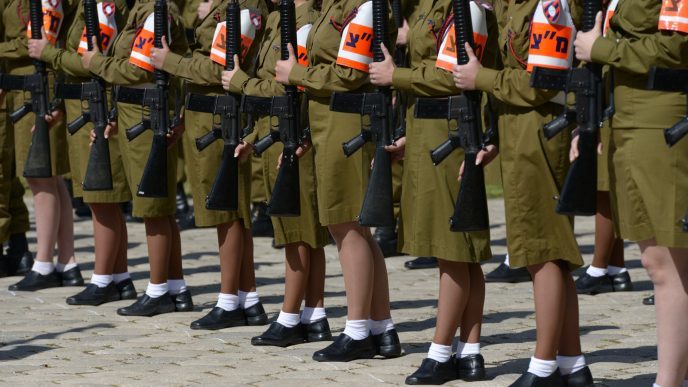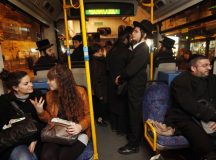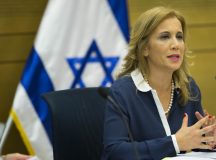Rachel Tevet Vizel was ‘gender advisor’ to the IDF Chief of Staff from 2011 to 2017,a period that saw a huge rise in religious women’s participation in the IDF. In this interview she addresses concerns about how successfully the desire to integrate women has been balanced with the desire to also integrate national-Religious and ultra-Orthodox conscripts, and how effectively the imperative of equal-opportunity has been balanced with the imperative to win wars. She makes the case for the coherence and balance of the middle way that has been pursued by the IDF, as embodied in the Joint-Service Ordinance she helped to draft and which set the rules for how men and women serve together.
Gender issues in the IDF
Calev Ben-Dor: You held the position of ‘gender advisor’ to the IDF Chief of Staff from 2011 to 2017. What did that role involve?
Rachel Tevet Vizel: The role of gender advisor to the IDF Chief of Staff includes two main areas. One deals with the rights of families and parents – issues such as maternity leave and sexual harassment. The other deals with how the army ensures that conscripted women experience meaningful service that will positively affect their future prospects.
Because Israel has compulsory service the army has a responsibility to make every individual’s service meaningful. And in Israel, when one searches for a job, one of the main things employers want to know is what one did in the army. Even in my current job as Director General of the National Road Safety Authority, what was perceived as most impressive on my CV wasn’t that I was a lawyer or a judge but that I reached rank of a Brigadier General. What each individual did in the army is part of how we define ourselves (and how society defines us).
For example, because many of the tech start-ups are launched by Israelis who served in special technology units in the army such as 8200, the army sees it as important to ensure that women have the opportunity to serve in these units. Forty per cent of computer units are now staffed by women while in intelligence units the figure is 50 per cent. In education units 80 per cent of soldiers serving there are still female.
CB-D: How has women’s service in the IDF changed over the years?
RTV: After the establishment of the state, Israel’s first Prime Minister David Ben-Gurion decided on compulsory service for men and women. One component in his decision was practical – there had been 2700 women had served in the Allied army against the Nazis; they knew how to fight and the country needed them. The problem was that in general Ben-Gurion saw the role of women in the army in a very ‘traditional’ way – that women should occupy positions of nurses etc.
The First Lebanon War was a watershed. The army suffered from a lack of personnel, and it understood that women – who constitute 30 per cent of human resources in the army – were capable of filling many military positions.
Another landmark was in 1995, when the Supreme Court handed down a decision on Alice Miller. She had gained a pilot’s license and a degree in aeronautical engineering and wanted to take the IDF pilot course tests, but the army refused. At that time I was serving as part of the legal branch in the IDF so was aware of what was going on behind the scenes. The army’s logic wasn’t that it didn’t think women were physically unable to be pilots; rather it stemmed from economic reasons. The investment the IDF makes in each pilot is based on the assumption that they will fly for over 10 years and the IDF assumed a women would ‘lose’ several years in that period away due to pregnancy and maternity leave. The Supreme Court’s decision ruled that it was incumbent on the air force to take into account the differences between men and women and the needs of women who were pilots, in order to give women an equal opportunity to serve.
Since 1995, an increasing number of occupations within the army have been opened to women, with the IDF checking its assumptions as to why each role had previously been considered closed. Now, 85 per cent of all professions in the army, including those in intelligence, technology and combat roles are open to women.
Because men and women are different, there will be some things that women won’t be physically able to do. For example, while a woman can be trained to run as fast as a man, she can’t be trained to carry the same weight on her back as a man. The army began to think about specific roles and specific missions, and if that role didn’t require lifting heavy weights, it could become open to women. One example of this is becoming the commander of a navy ship. The course was seen as one of the toughest in the army, and it was closed to women for many years. But when the IDF began to consider the specific missions it realised that it didn’t need to be closed to women. Ultimately, most women can’t physically cope with getting into these elite units in the first place. But neither can most men.
Religious women, and mixed units: The National-Religious community and the IDF
CB-D: There has been a strong increase in the number of religious women serving in the army – from 900 enlisting in 2010, to over 2,700 over the last year. There also seem to be conflicting trends within the National Religious community in responding to this. For example, some Rabbis have come out against such service for women as well as opposing service for religious men in mixed units. At the same time over 200 youngsters from the National-Religious sector of pre-draft age signed a letter to the Orthodox Zionist leadership in which they said: ‘We have confidence in the army leadership’s desire to find ways that will make it possible to serve together, each according to his or her faith, either in field units or in rear-line units.’ How do you understand these trends?
RTV: The number of young women from the religious Zionist camp who serve in the army now stands at 30 per cent, a far greater number than in the past. One thing that has changed is that women from this community now realise that they can maintain their religiosity when they go to the army. My daughter is about to become an intelligence officer and has had no problem maintaining her observance. Moreover, a recent large survey published by Aluma showed that 87 per cent of religious women said they either stayed religious or became stronger in their religiosity during their army service.
The second thing that has changed is that when religious women look at their environment, the women they see in leadership roles all went to the army. This is part of the country’s legacy. In light of this, they are increasingly asking why they should not go into the army.
Those Rabbis from the National-Religious camp trying to prevent girls serving aren’t using reasons drawn from Halakha (Jewish law). Rather they argue that army service will cause women to stop being religious, or that religious women will suffer from sexual harassment. I dealt with sexual harassment in the army and know the statistics: Firstly, we have fewer cases of sexual harassment in the army than in universities. And the units with the fewest cases of sexual harassment are actually those mixed units – because everyone sees themselves as part of the same team.
These young religious women who are joining the IDF have the experience of their sisters and friends from youth movements who have gone through this process and are evidence to the opposite of what the Rabbis claim. These women feel that the Rabbis are simply out of touch with reality, and often feel confident enough in their place in society that they won’t let religious authorities tell them what to do, which in turn creates fear among these authorities.
CB-D: Another part of the controversy in the National-Religious world has been about mixed gender units, with religious critics claiming that the army is promoting a type of social engineering in pushing for men and women to serve together. Is there any truth in this?
RTV: This is completely false. The goal of the army is to win wars. Period. And any action that contradicts this won’t be implemented.
When we talk about mixed units, the concern of the National-Religious Rabbis isn’t about intelligence units, or engineering, or computing – in which the interaction of men and women is similar to university – but rather with combat units. But there are only four mixed gender battalions, and the women in these battalions are volunteers, and religious men have the choice to only be with other men.
The logic behind these mixed combat units is that the army needs to maximise use of its human resources. And using all the men and women who are qualified to be involved in a variety of regular missions also allows other elite units to be taken away from regular jobs such as guarding the border and being moved to other areas they are needed.
There is an additional value at play here, equal opportunity, but this isn’t the ultimate value; the ultimate value is winning wars.
A ‘women sterile service’? The IDF and ultra-Orthodox
CB-D: The IDF has also created units that are specifically for ultra-Orthodox men. We have spoken to a number of people who gave examples of women who have been negatively affected by this. Others have argued that there has been an unfair trade-off – that the army has created a ‘Women Sterile Service’ [an IDF phrase] where men don’t even have to receive their kitbag from a woman. An IDF Joint-Service Ordinance said that women should be modest and whenever there is risk of immodest encounters, men will be able to refuse to be next to a woman – even to refuse to have a female rifle instructor. Can you respond to this and share some of the discussions that took place within the IDF on this issue?
RTV: I was part of a group of brigadier generals who discussed and drafted the IDF Joint-Service Ordinance that was aimed at setting rules for how men and women can serve together in the IDF. For example, one section deals with privacy, and determined that men and women should have different dormitories and that men can’t go inside women’s dormitories.
One of the other sections in the Joint Service Ordinance deals with religious male and female soldiers. It says that in terms of combatants – only in combat units rather than other units such as technology, engineering, or others – a religious person can choose not to serve with a member of the other sex. But it is only if its combat related. They can’t say they don’t want the chef to be female.
The only place where there are really no women – and this is a problem – is in those units in which ultra-Orthodox serve, because they have their own male-only units. In contrast to National-Religious soldiers, these units are comprised of men who don’t ever come into any contact with women in their own society. Yet even here, it is only in combat units – an ultra-Orthodox man who wants to serve in an intelligence unit can’t demand not to be surrounded by women.
The rules of modesty the IDF instituted are for everyone, not just religious soldiers. Some commanders have taken this to an extreme – for example they feel that because they have lots of religious soldiers they should prevent women from walking around in t-shirts. But no such rule appears anywhere in the Joint Service Ordinance.
CB-D: We were told a story of a woman who worked in logistics and was told that she couldn’t take a course that would have advanced her position, because it was enough for one religious soldier to say that he didn’t want a woman on his course for her to be excluded.
RTV: Such a thing is simply not legal. When I was in the IDF I heard such stories but they were always outliers. Of course there are extreme people. But when one looks at the army as a whole this is not representative, and is generally not what commanders are telling their soldiers.







































I was most impressed by the fact that the sexual harassment rate is lower in the IDF than in universities and that it is in mixed units that the rate of harassment is lowest.
In Britain the first large scale use of female auxiliary corps was in World War I. Understandably the press found some offence somewhere and got a question in Parliament. It turned out the rate of illegitimate births in the forces was below the national civilian percentage [for the age group].